Một số định nghĩa Kinh tế học
Definitions of Economics
Some version of the traditional definition of economics is found in almost every introductory economics textbook:
"Economics is the study of how scarce resources are most efficiently allocated among alternative goals."
When an economist refers to "scarce resources," she does not necessarily mean something rare, like diamonds. She means resources that are not available in unlimited quantity at zero cost. Thus, scarce resources include everything we can think of that might be used in producing any kind of good or service. Economists often classify resources into three types: capital, labor, and land.
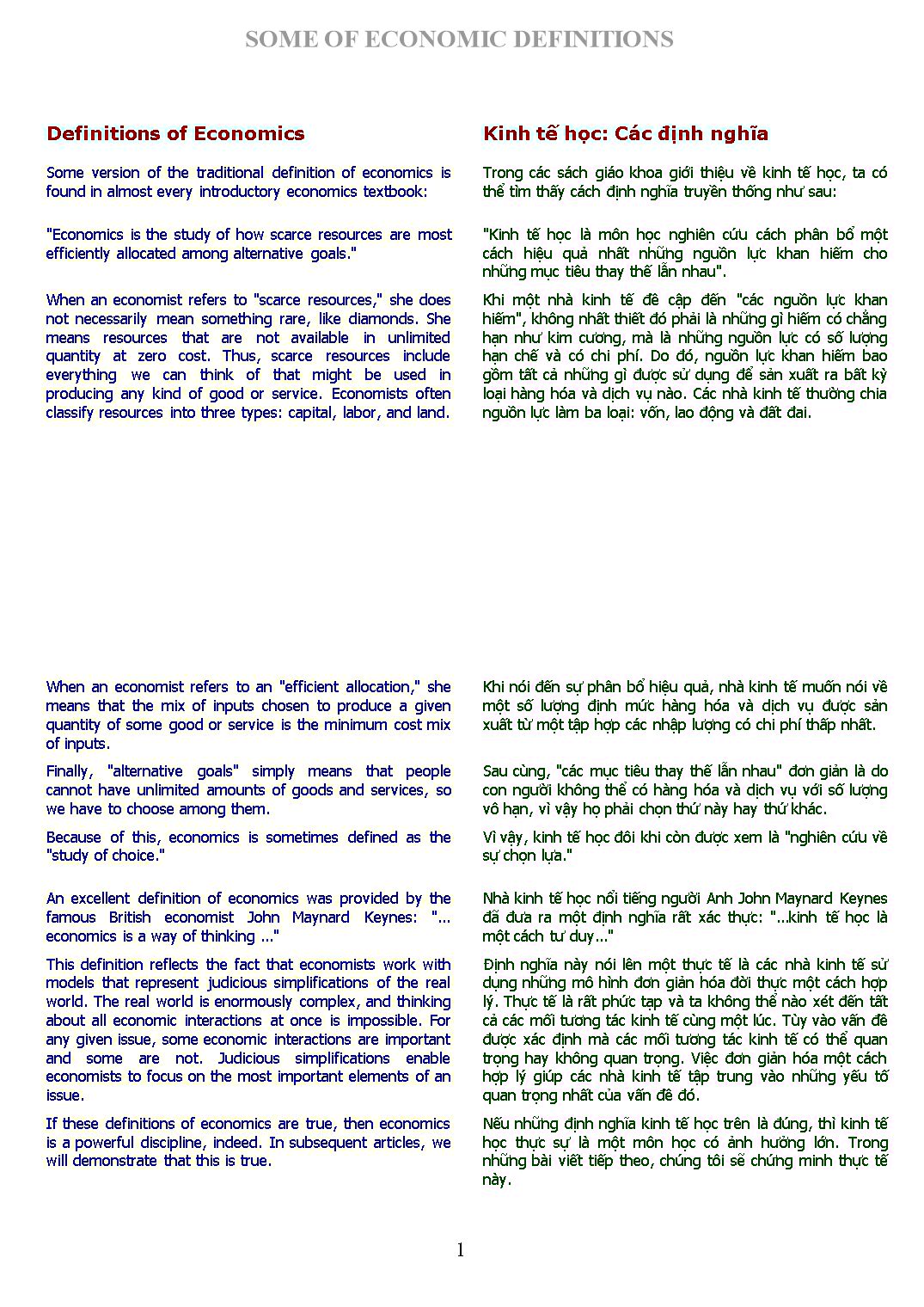
Trang 1
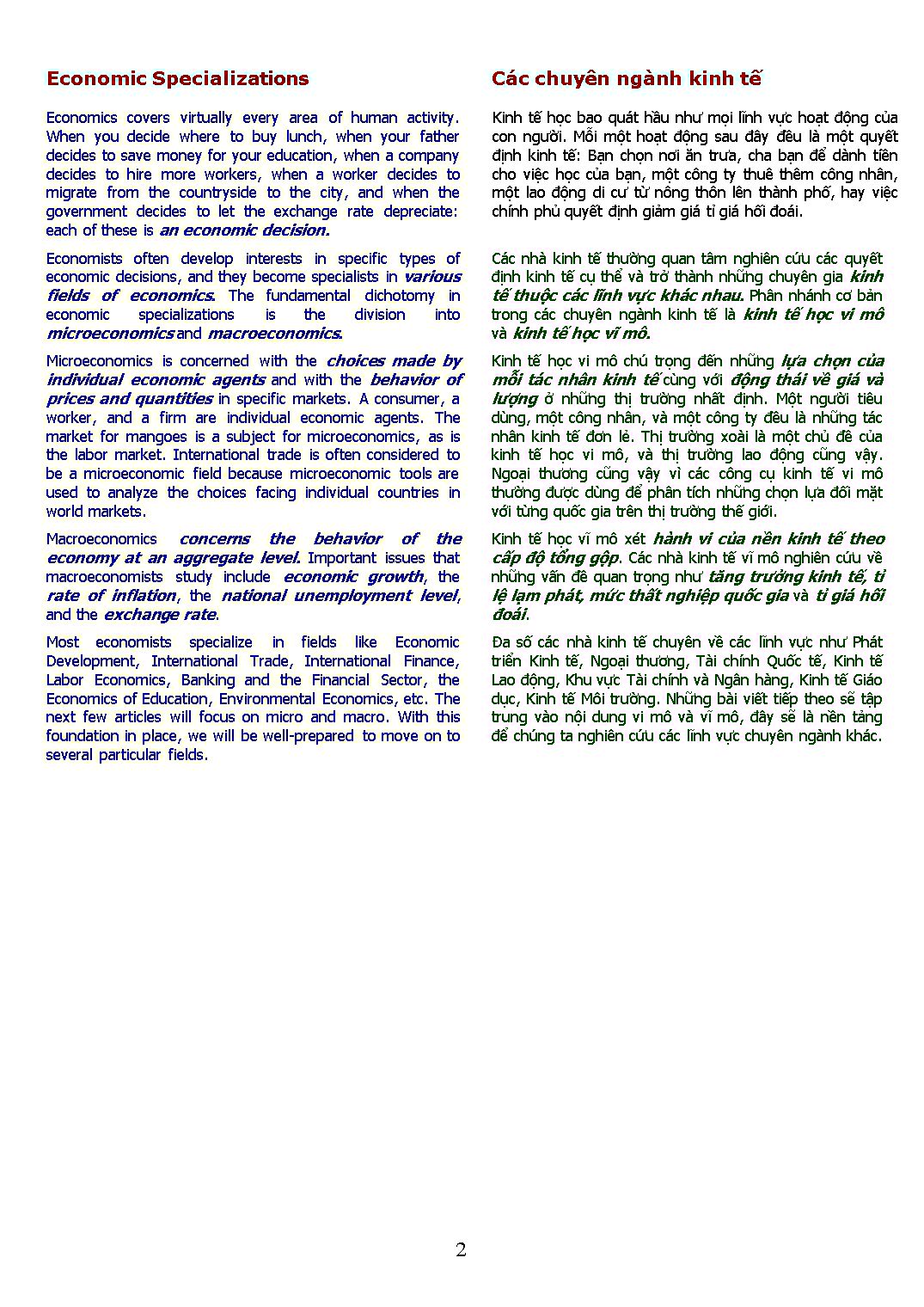
Trang 2
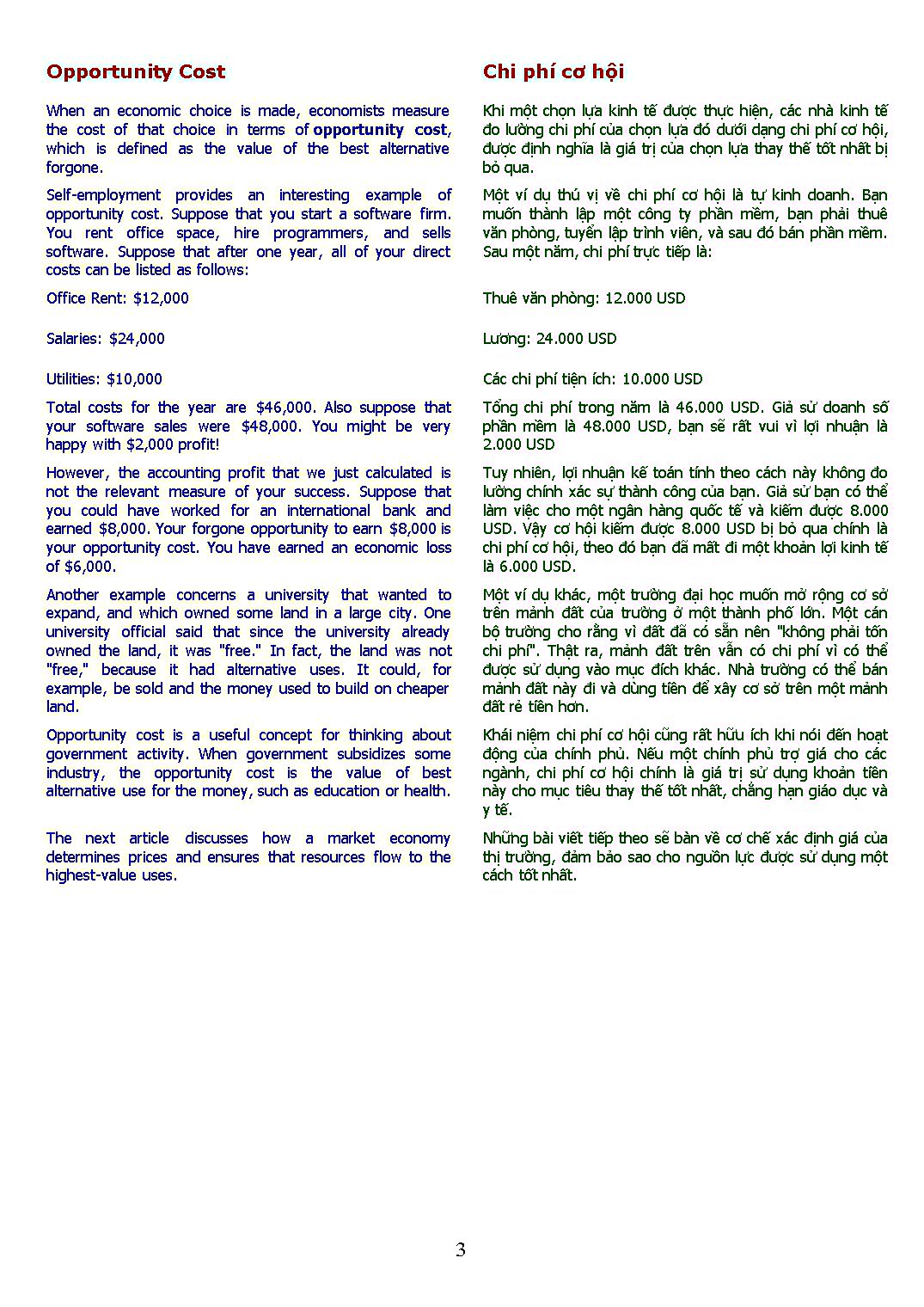
Trang 3
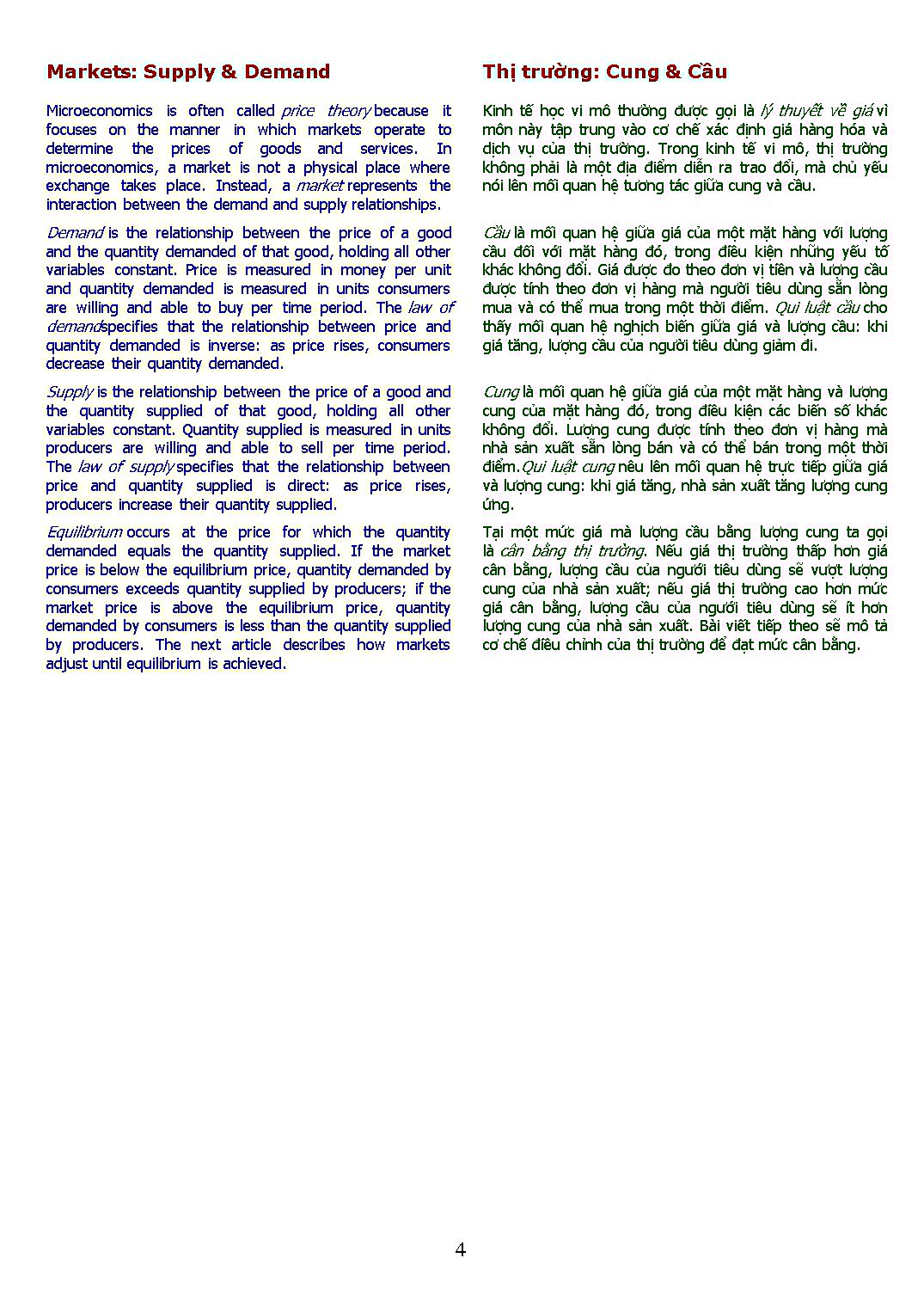
Trang 4
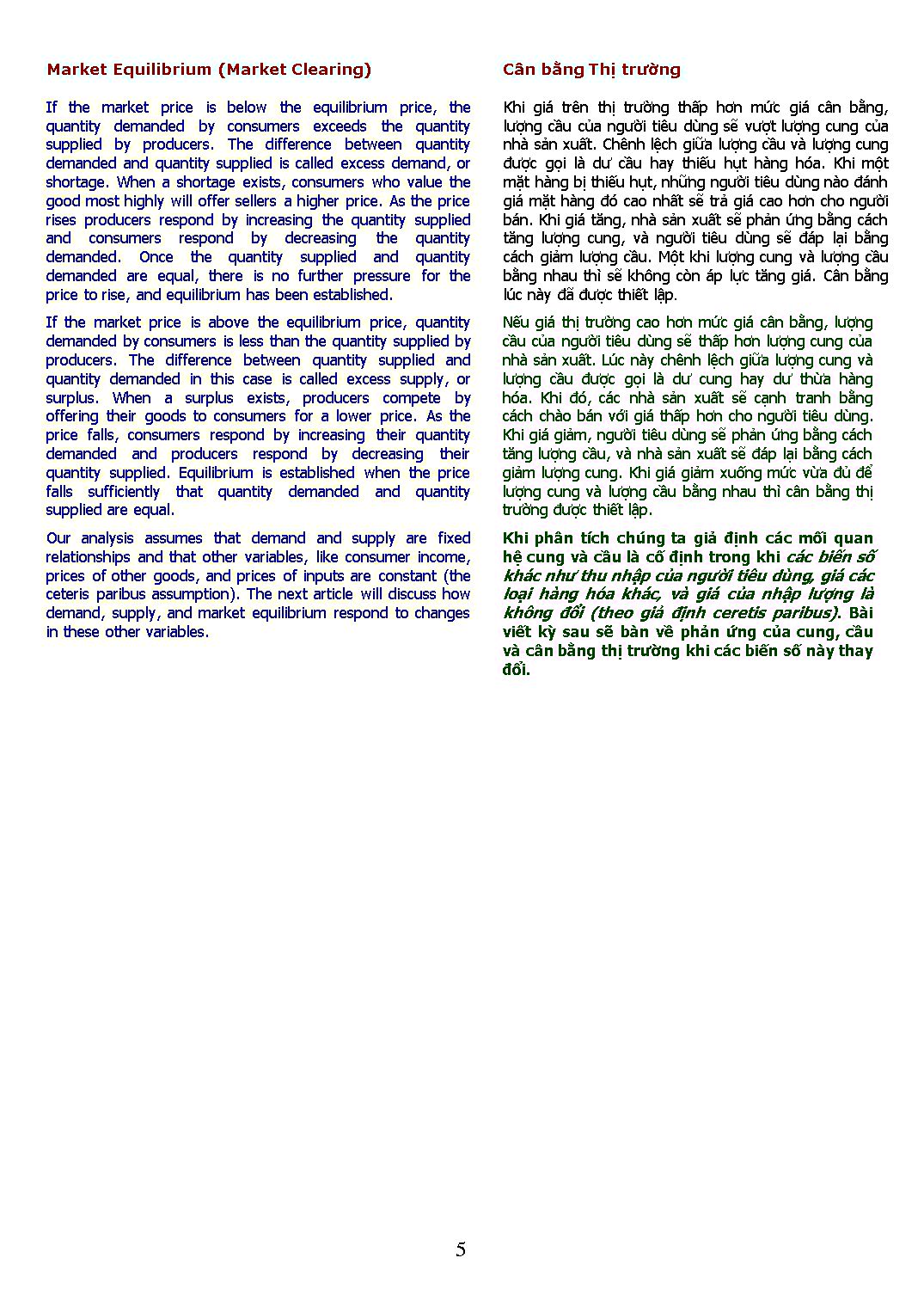
Trang 5
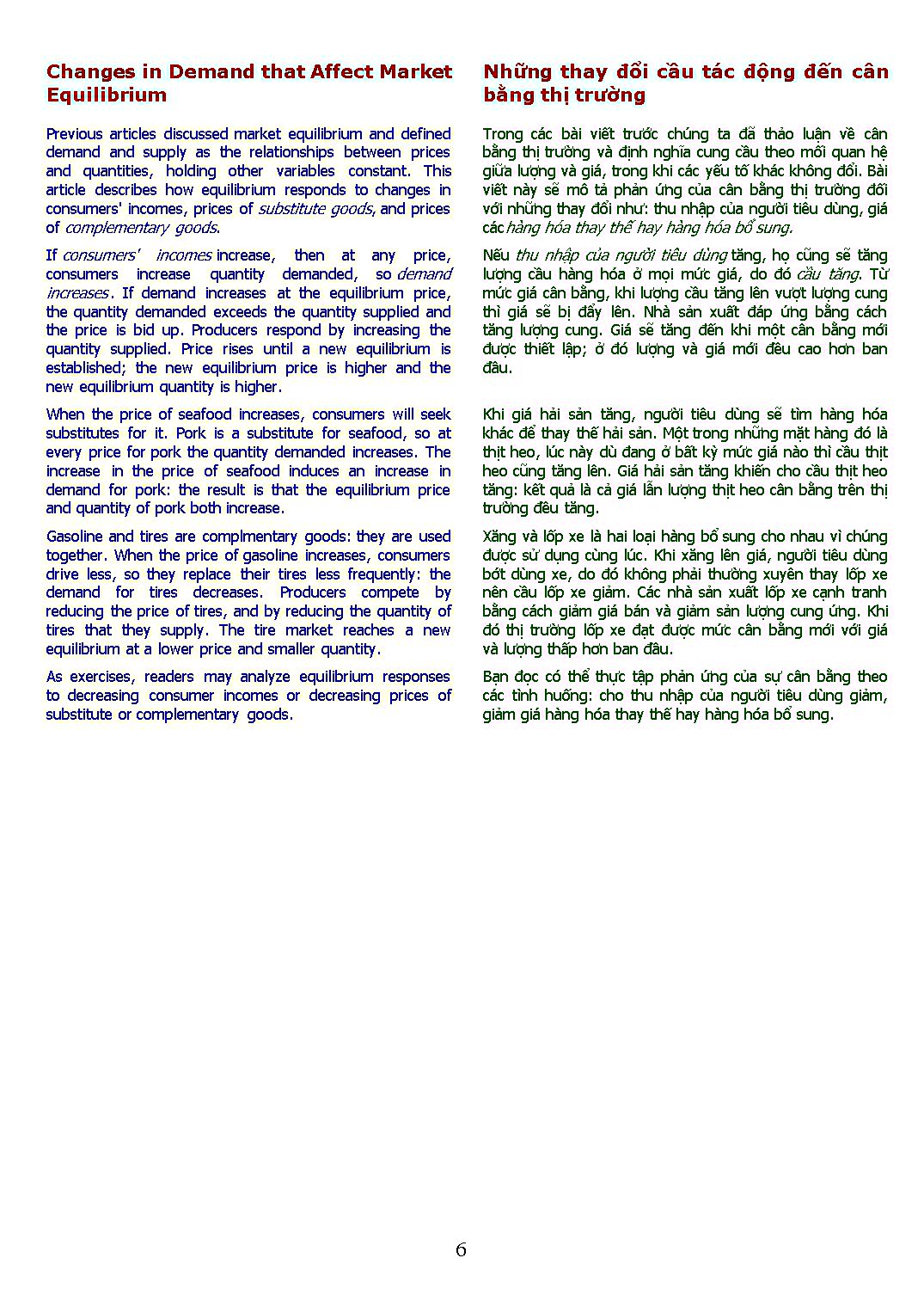
Trang 6
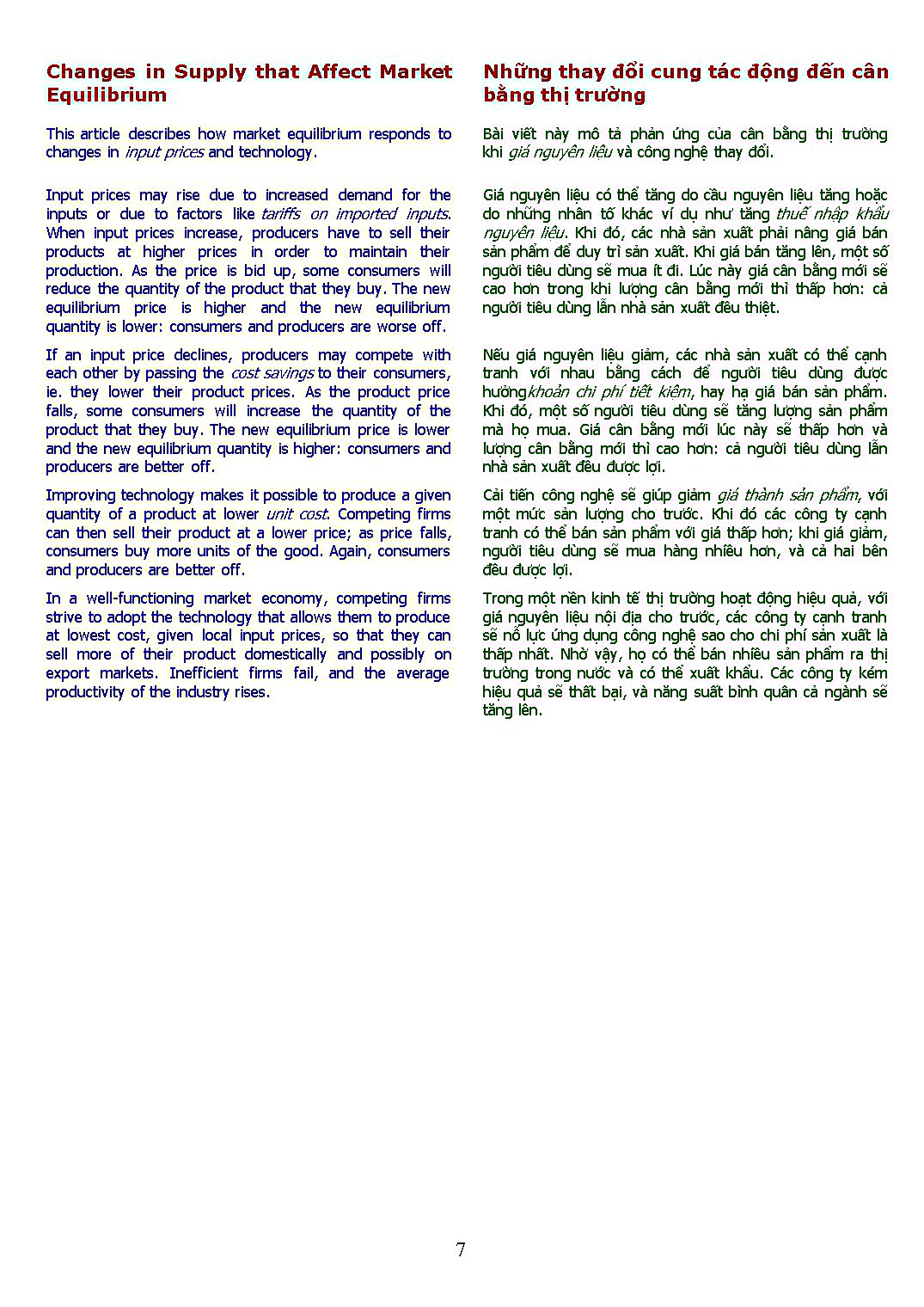
Trang 7
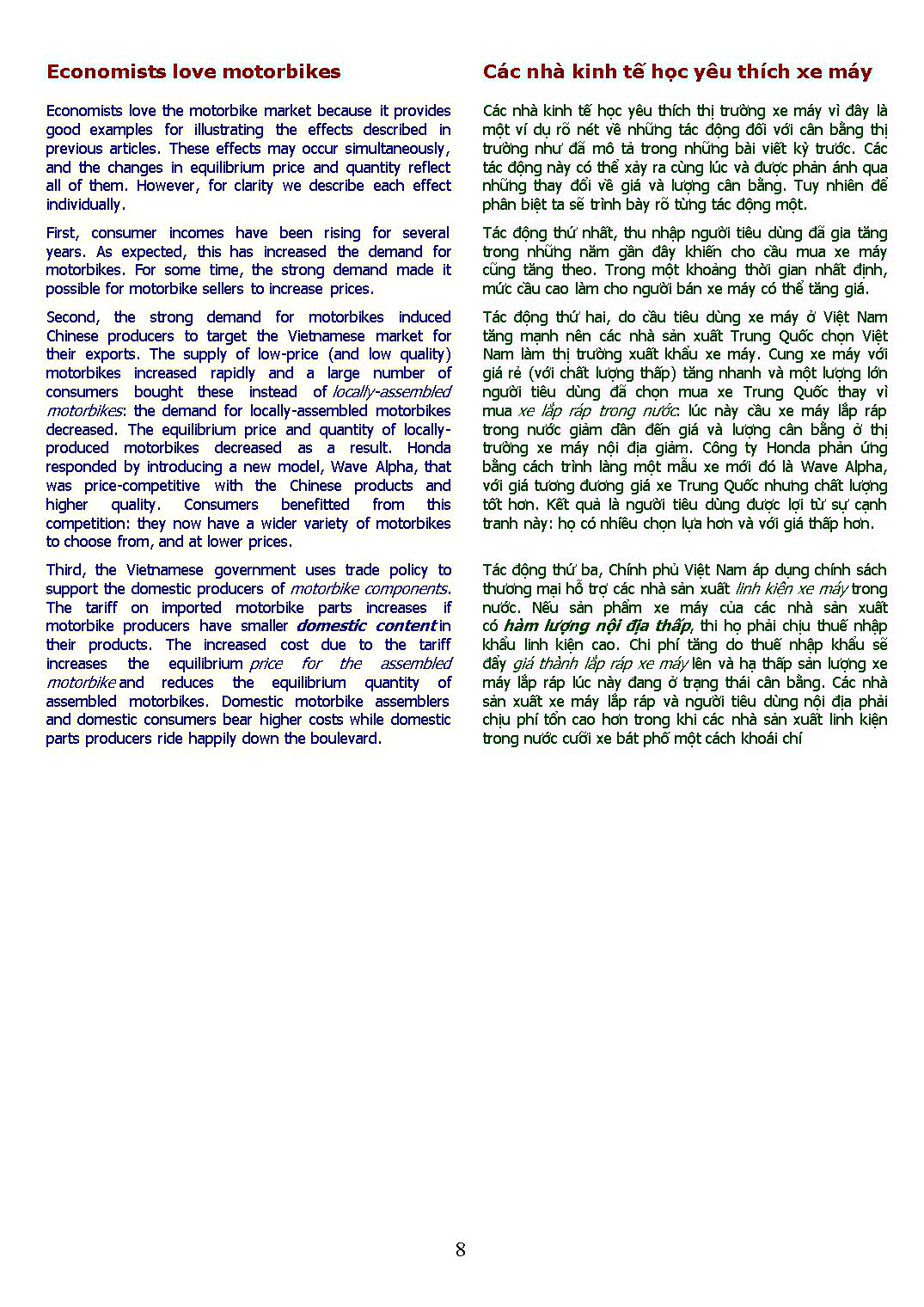
Trang 8
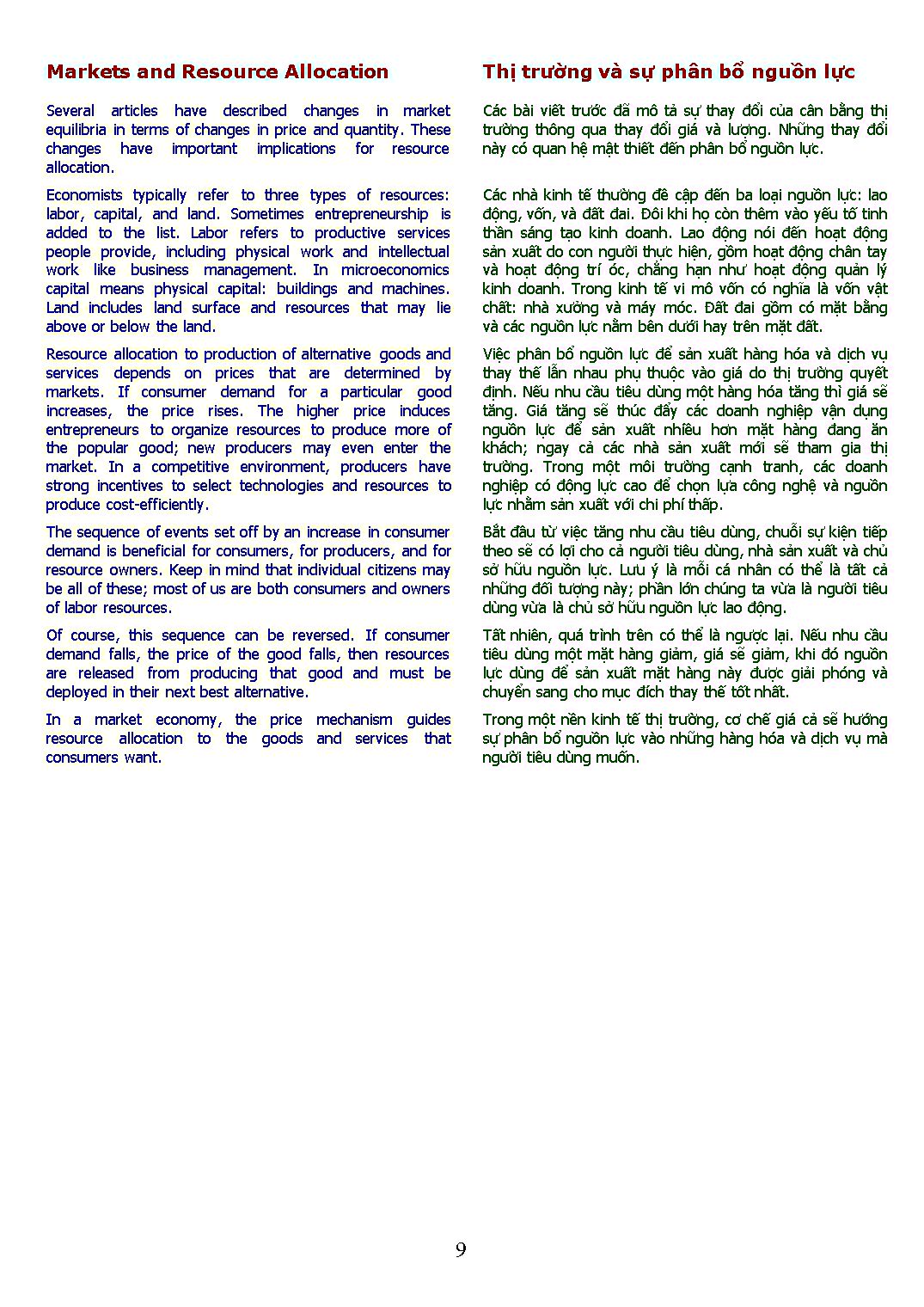
Trang 9
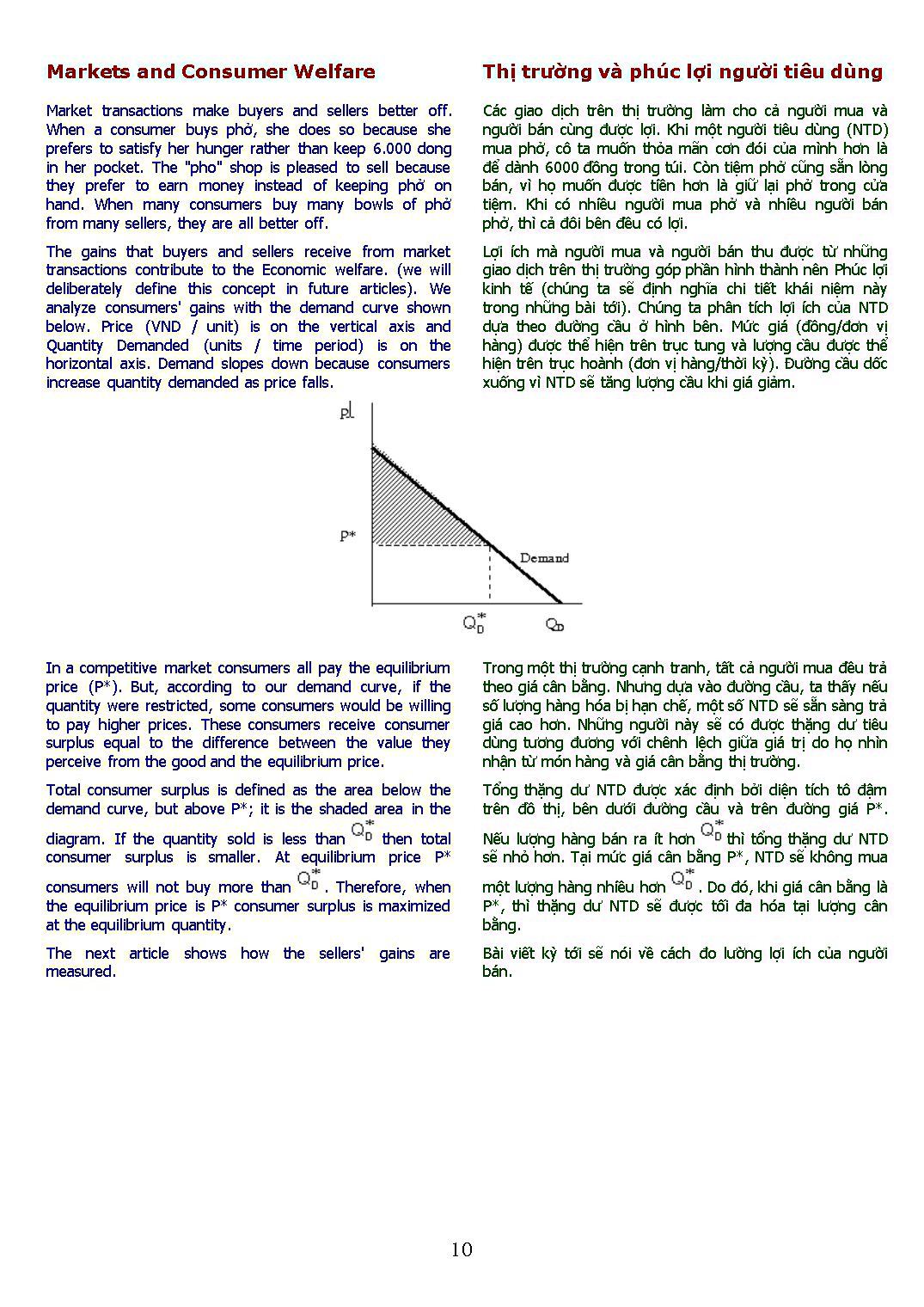
Trang 10
Tải về để xem bản đầy đủ
Bạn đang xem 10 trang mẫu của tài liệu "Một số định nghĩa Kinh tế học", để tải tài liệu gốc về máy hãy click vào nút Download ở trên
Tóm tắt nội dung tài liệu: Một số định nghĩa Kinh tế học
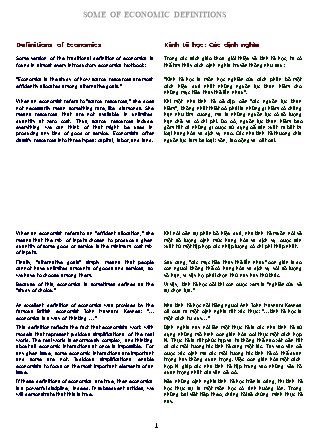
SOME OF ECONOMIC DEFINITIONS Definitions of Economics Kinh tế học: Các định nghĩa Some version of the traditional definition of economics is found in almost every introductory economics textbook: Trong các sách giáo khoa giới thiệu về kinh tế học, ta có thể tìm thấy cách định nghĩa truyền thống như sau: "Economics is the study of how scarce resources are most efficiently allocated among alternative goals." "Kinh tế học là môn học nghiên cứu cách phân bổ một cách hiệu quả nhất những nguồn lực khan hiếm cho những mục tiêu thay thế lẫn nhau". When an economist refers to "scarce resources," she does not necessarily mean something rare, like diamonds. She means resources that are not available in unlimited quantity at zero cost. Thus, scarce resources include everything we can think of that might be used in producing any kind of good or service. Economists often classify resources into three types: capital, labor, and land. Khi một nhà kinh tế đề cập đến "các nguồn lực khan hiếm", không nhất thiết đó phải là những gì hiếm có chẳng hạn như kim cương, mà là những nguồn lực có số lượng hạn chế và có chi phí. Do đó, nguồn lực khan hiếm bao gồm tất cả những gì được sử dụng để sản xuất ra bất kỳ loại hàng hóa và dịch vụ nào. Các nhà kinh tế thường chia nguồn lực làm ba loại: vốn, lao động và đất đai. When an economist refers to an "efficient allocation," she means that the mix of inputs chosen to produce a given quantity of some good or service is the minimum cost mix of inputs. Khi nói đến sự phân bổ hiệu quả, nhà kinh tế muốn nói về một số lượng định mức hàng hóa và dịch vụ được sản xuất từ một tập hợp các nhập lượng có chi phí thấp nhất. Finally, "alternative goals" simply means that people cannot have unlimited amounts of goods and services, so we have to choose among them. Sau cùng, "các mục tiêu thay thế lẫn nhau" đơn giản là do con người không thể có hàng hóa và dịch vụ với số lượng vô hạn, vì vậy họ phải chọn thứ này hay thứ khác. Because of this, economics is sometimes defined as the "study of choice." Vì vậy, kinh tế học đôi khi còn được xem là "nghiên cứu về sự chọn lựa." An excellent definition of economics was provided by the famous British economist John Maynard Keynes: "... economics is a way of thinking ..." Nhà kinh tế học nổi tiếng người Anh John Maynard Keynes đã đưa ra một định nghĩa rất xác thực: "...kinh tế học là một cách tư duy..." This definition reflects the fact that economists work with models that represent judicious simplifications of the real world. The real world is enormously complex, and thinking about all economic interactions at once is impossible. For any given issue, some economic interactions are important and some are not. Judicious simplifications enable economists to focus on the most important elements of an issue. Ðịnh nghĩa này nói lên một thực tế là các nhà kinh tế sử dụng những mô hình đơn giản hóa đời thực một cách hợp lý. Thực tế là rất phức tạp và ta không thể nào xét đến tất cả các mối tương tác kinh tế cùng một lúc. Tùy vào vấn đề được xác định mà các mối tương tác kinh tế có thể quan trọng hay không quan trọng. Việc đơn giản hóa một cách hợp lý giúp các nhà kinh tế tập trung vào những yếu tố quan trọng nhất của vấn đề đó. If these definitions of economics are true, then economics is a powerful discipline, indeed. In subsequent articles, we will demonstrate that this is true. Nếu những định nghĩa kinh tế học trên là đúng, thì kinh tế học thực sự là một môn học có ảnh hưởng lớn. Trong những bài viết tiếp theo, chúng tôi sẽ chứng minh thực tế này. Economic Specializations Các chuyên ngành kinh tế Economics covers virtually every area of human activity. When you decide where to buy lunch, when your father decides to save money for your education, when a company decides to hire more workers, when a worker decides to migrate from the countryside to the city, and when the government decides to let the exchange rate depreciate: each of these is an economic decision. Kinh tế học bao quát hầu như mọi lĩnh vực hoạt động của con người. Mỗi một hoạt động sau đây đều là một quyết định kinh tế: Bạn chọn nơi ăn trưa, cha bạn để dành tiền cho việc học của bạn, một công ty thuê thêm công nhân, một lao động di cư từ nông thôn lên thành phố, hay việc chính phủ quyết định giảm giá tỉ giá hối đoái. Economists often develop interests in specific types of economic decisions, and they become specialists in various fields of economics. The fundamental dichotomy in economic specializations is the division into microeconomics and macroeconomics. Các nhà kinh tế thường quan tâm nghiên cứu các quyết định kinh tế cụ thể và trở thành những chuyên gia kinh tế thuộc các lĩnh vực khác nhau. Phân nhánh cơ bản trong các chuyên ngành kinh tế là kinh tế học vi mô và kinh tế học vĩ mô. Microeconomics is concerned with the choices made by individual economic agents and with the behavior of prices and quantities in specific markets. A consumer, a worker, and a firm are individual economic agents. The market for mangoes is a subject for microeconomics, as is the labor market. International trade is often considered to be a microeconomic field because microeconomic tools are used to analyze the choices facing individual countries in world markets. Kinh tế học vi mô chú trọng đến những lựa chọn của mỗi tác nhân kinh tế cùng với động thái về giá và lượng ở những thị trường nhất định. Một người tiêu dùng, một công nhân, và một công ty đều là những tác nhân kinh tế đơn lẻ. Thị trường xoài là một chủ đề của kinh tế học vi mô, và thị trường lao động cũng vậy. Ngoại thương cũng vậy vì các công cụ kinh tế vi mô thường được dùng để phân tích những chọn lựa đối mặt với từng quốc gia trên thị trường thế giới. Macroeconomics concerns the behavior of the economy at an aggregate level. Important issues that macroeconomists study include economic growth, the rate of inflation, the national unemployment level, and the exchange rate. Kinh tế học vĩ mô xét hành vi của nền kinh ... downward sloping demand curve, the introduction of the new project leads to a decrease in the market price. The consumers of the product will welcome the new project whereas the existing producers would be unhappy with the new project. The decrease in the price leads to an increase in consumer surplus and this in turn leads to an increase in the quantity demanded. At the same time, the decrease in the price leads to a decrease in producer surplus and this in turn leads to a decrease in the quantity supplied. Đa số mọi người quen thuộc với giá trị tài chính vì họ thường xuyên thực hiện các giao dịch với giá trị tài chính. Tuy nhiên, ý nghĩa của giá trị kinh tế là gì? Có thể minh họa khái niệm giá trị kinh tế bằng một ví dụ đơn giản, xét một dự án mới sản xuất ra sản lượng X. Giả định thị trường cạnh tranh hoàn hảo và không có các biến dạng như thuế và trợ cấp. Trong mô hình chuẩn với đường cung có độ dốc hướng lên và đường cầu có độ dốc đi xuống, dự án được triển khai sẽ làm giá thị trường giảm đi. Người tiêu dùng sản phẩm này sẽ chào đón dự án mới trong khi các nhà sản xuất hiện tại không hài lòng với nó. Giá giảm khiến thặng dư tiêu dùng tăng và lượng cầu cũng tăng. Đồng thời, giá giảm làm thặng dư sản xuất và cả quả lượng cung đều giảm. One way to measure the impact of the new project is to use the demand curve to measure the benefits to the consumers and the supply curve to measure the value of the resources used by the producers. Concretely, the total benefit of the new project is the sum of the appropriate areas under the demand and supply curves. The area under the supply curve is a “benefit” of the new project because the decrease in the quantity supplied means that resources that would have used in the production of output X by the existing producers are available for others to use. Có thể đo lường tác động của dự án mới này bằng cách sử dụng đường cầu để tính lợi ích đối với người tiêu dùng và đường cung để xác định nguồn lực mà nhà sản xuất sử dụng. Cụ thể, tổng lợi ích của dự án mới là tổng diện tích tương ứng bên dưới đường cầu và đường cung. Phần diện tích bên dưới đường cung là “lợi ích” của dự án mới vì lượng cung giảm cũng đồng nghĩa với việc những nguồn lực lẽ ra đã được các nhà sản xuất hiện nay sử dụng để sản xuất ra sản lượng X, nay có thể được dùng cho mục đích khác. The relevant area under the demand curve lies between the new quantity demanded and the original market equilibrium. Similarly, the relevant area under the supply curve lies between the new quantity supplied and the original market equilibrium. Phần diện tích bên dưới đường cầu giới hạn giữa lượng cầu mới và lượng cân bằng thị trường ban đầu. Tương tự, giới hạn phần diện tích dưới đường cung là giữa lượng cung mới và lượng cân bằng thị trường ban đầu. To obtain the economic value per unit of output, we divide the total area by the output of the project. Để đạt được giá trị kinh tế trên mỗi đơn vị sản lượng, chúng ta chia tổng diện tích trên cho tổng sản lượng của dự án. Economic versus accounting income So sánh thu nhập kinh tế và thu nhập kế toán The distinction between economic and accounting income is important. Consider a person who earns an annual salary of $15,000. At the same time, the person owns a house whose value increases this year. What is the correct assessment of the person’s income? From one point of view, the annual income is simply the person’s salary. How should we think about the increase in the value of the house? Should we include the change in the value of the house as part of the annual income? What are the arguments for including or excluding the changes in the values of assets? Phân biệt giữa thu nhập kinh tế và thu nhập kế toán là điều rất quan trọng. Xét một người có lương hàng năm là 15.000 đô-la. người này cũng có một căn nhà mà giá trị năm nay đã tăng lên. Chúng ta nên đánh giá thu nhập của người này thế nào cho chính xác? Có quan điểm cho rằng thu nhập hàng năm đơn giản là lương của anh ta. Còn giá trị gia tăng của ngôi nhà thì sao? Liệu chúng ta có nên tính phần giá trị thay đổi của ngôi nhà như một phần của thu nhập hàng năm hay không? Đâu là cơ sở cho việc tính gộp hoặc tách biệt những thay đổi trong giá trị của tài sản? In the definition of accounting income, we exclude the change in the value of the house. However, in the definition of economic income, we take into account the change in the value of the house. Which definition is more correct? Trong định nghĩa của thu nhập kế toán, chúng ta không tính phần thay đổi trong giá trị căn nhà. Tuy nhiên, theo định nghĩa của thu nhập kinh tế, chúng ta phải tính luôn cả phần giá trị thay đổi của căn nhà. vậy định nghĩa nào chính xác hơn? From a conceptual point of view, the economic definition of income is comprehensive and thus more correct. People’s expenditures are a function of their economic income. If the value of the house increases over time, the owner is more wealthy and likely to increase his expenditures. However, from a practical point of view, it is difficult to measure economic income on a regular basis. Thus, it is more common for people to use the accounting definition of income rather than the economic definition, even though the economic definition is technically better. Theo lý thuyết, định nghĩa kinh tế của thu nhập là toàn diện và do đó chính xác hơn. Chi tiêu của người dân phụ thuộc vào thu nhập kinh tế của họ. Nếu giá trị của căn nhà tăng theo thời gian, chủ nhà sẽ giàu có hơn và có khuynh hướng gia tăng chi tiêu. Tuy nhiên, từ quan điểm thực tế, thường xuyên đo lường thu nhập kinh tế là điều rất khó. Do đó, người ta dùng định nghĩa kế tóan phổ biến hơn định nghĩa kinh tế, dù rằng định nghĩa kinh tế trên nguyên tắc là tốt hơn. Using a 2 by 2 matrix to pigeonhole a project Sử dụng ma trận 2x2 để phân loại dự án One of the key objectives of project appraisal is to select good projects and stop bad projects. More specifically, the analyst should approve projects that are good from the economic point of view. Simply stated, good projects increase the wealth of a country and bad projects decrease the wealth of a country. The economic point of view (also known as the society’s point of view) takes into account the actual benefits to the stakeholders of the project and the actual value of the resources that are required by the project. When there are distortions in the economy, the discrepancies between the economic cash flows and financial cash flows may be huge. A project is good from the society’s point of view if the net (economic) cash flow, discounted by the economic discount rate, is positive. Một trong những mục tiêu quan trọng của thẩm định dự án là chọn lựa dự án tốt và loại bỏ dự án không tốt. Cụ thể hơn, nhà phân tích nên chấp thuận các dự án tốt dựa trên quan điểm kinh tế. Có thể nói đơn giản rằng những dự án tốt làm tăng của cải của quốc gia còn những dự án xấu thì ngược lại. Quan điểm kinh tế (hay còn gọi là quan điểm xã hội) xét đến những lợi ích thực mà các bên liên quan trong dự án nhận được và giá trị thực của nguồn lực mà dự án sử dụng. Khi có biến dạng trong nền kinh tế, khác biệt giữa ngân lưu kinh tế và ngân lưu tài chính có thể lớn. Một dự án được xem là tốt theo quan điểm xã hội nếu ngân lưu (kinh tế) ròng là dương sau khi đã được qui đổi theo suất chiết khấu kinh tế. We can use a simple 2 by 2 matrix (see below) to summarize the decision rules for assessing a project. If the project is good from both the financial and economic points of view, the decision is simple: we should approve the project. (Upper left cell of the matrix). Similarly, if the project is bad from both the financial and economic points of view, the decision is simple: we should reject the project. (Lower right cell of the matrix). Chúng ta có thể sử dụng ma trận 2x2 bên dưới để tóm tắt các nguyên tắc quyết định khi đánh giá một dự án. Nếu dự án được xem là tốt xét theo cả hai quan điểm kinh tế và tài chính, thì quyết định là đơn giản: chúng ta nên chấp thuận dự án (ô bên trái phía trên). Tương tự nếu đây là dự án tồi xét theo cả hai quan điểm kinh tế và tài chính, thì quyết định cũng đơn giản: chúng ta nên từ chối dự án (ô bên phải phía dưới). The decision rules for the other two cells are more problematic. In the lower left cell of the matrix, the project is bad from the economic point of view, and we should reject the project. However, stakeholders who have a vested financial interest in the project may exert tremendous pressure to approve the project. In the upper right cell of the matrix, the project is good from the economic point of view, and we should implement the project. However, since the financial analysis is bad, it may be difficult to finance the project, especially if the government budget does not have the financial resources. Nguyên tắc quyết định đối với hai ô còn lại là khá rắc rối. Ở ô bên trái phía dưới, dự án không tốt theo quan điểm kinh tế nên chúng ta không chấp thuận. Tuy nhiên, những bên liên quan có quyền lợi đặc biệt về mặt tài chính của dự án có thể gây áp lực mạnh để dự án được chấp thuận. Ở ô bên phải phía trên của ma trận, dự án theo quan điểm tài chính là tốt nên chúng ta cần cho phép thực hiện. Tuy nhiên, vì phân tích tài chính cho kết quả xấu, nên rất khó để huy động vốn tài trợ cho dự án, đặc biệt khi ngân sách chính phủ không có nguồn tài chính. Using the simple 2 by 2 matrix to pigeonhole a project can go a long way in improving project selection. Joseph Tham Việc sử dụng ma trận 2x2 đơn giản để phân loại một dự án có giúp thể cải thiện nhiều trong chọn lựa dự án. Financial analysis: good Phân tích tài chính: tốt Financial analysis: bad Phân tích tài chính: xấu Economic analysis: good Phân tích kinh tế: tốt We should approve the project Chấp thuận dự án We should implement the project but Nên thực hiện dự án nhưng Economic analysis: bad Phân tích kinh tế: xấu We should reject the project but Nên từ chối dự án nhưng Stop the project. Bác bỏ dự án. Comparative Performance Measurement Đối chiếu thành quả chi tiêu Governments are invariably constrained by limited resources. The demand for goods and services always exceeds the capacity of the public sector to finance them. Even after engaging in partnerships with the private sector and eliciting the participation of non-profit and community based organizations, government resources are still insufficient to meet the needs of its citizens. Chính phủ nào cũng bị hạn chế bởi nguồn lực khan hiếm. Nhu cầu về hàng hóa và dịch vụ luôn vượt quá khả năng tài chính của khu vực công. Ngay cả sau khi hình thành quan hệ đối tác với khu vực tư nhân và lôi kéo sự tham gia của các tổ chức phi lợi nhuận cũng như các tổ chức cộng đồng, nguồn lực của chính phủ vẫn không đủ để đáp ứng nhu cầu của người dân. The most common way governments close this fiscal gap is by increasing revenue, either by raising taxes and user charges now, or by borrowing and then later raising taxes and user charges to finance debt repayment. Để lấp khoản thâm hụt ngân sách này, cách thông thường nhất là các chính phủ tăng thu ngân sách, bằng cách tăng thuế và phí sử dụng hiện tại, hoặc đi vay và sau đó tăng thuế và phí sử dụng để trả nợ. An alternative way to close the fiscal gap is to increase expenditure efficiency and expenditure effectiveness. If the government can get more value for its money by lowering costs (efficiency) and improving results (effectiveness), then it can use the same level of resources to provide more or better quality goods and services. Politically, this is often preferable to increasing taxes and user charges. Một cách khác để lấp lỗ hổng ngân sách này là gia tăng hiệu quả về chi phí lẫn mục đích trong chi tiêu. Nếu chính phủ có thể thu được nhiều giá trị hơn từ số tiền bỏ ra bằng cách giảm chi phí (hiệu quả chi phí) và cải thiện kết quả (đạt mục tiêu), thì với cùng một nguồn lực chính phủ có thể cung cấp hàng hóa và dịch vụ nhiều hơn và tốt hơn. Về mặt chính trị, cách làm này được ưa chuộng hơn là tăng thuế và phí sử dụng. A useful tool in improving expenditure efficiency and effectiveness is “comparative performance measurement,” or “CPM.” Cost data by themselves do not tell us very much, but comparisons of cost data over several years, or between many jurisdictions, turn these numbers into very useful information to evaluate the government’s expenditure performance. Một công cụ hữu ích nhằm cải thiện hiệu quả chi phí và mục đích là “đối chiếu thành quả chi tiêu” hay CPM. Bản thân số liệu về chi phí không nói ra nhiều điều, nhưng việc so sánh số liệu chi phí qua nhiều năm hoặc giữa các đơn vị hành chính sẽ biến những con số này thành thông tin rất hữu ích để đánh giá kết quả chi tiêu của chính phủ. CPM is done on a routine basis in the United States, where local governments have established and regularly publish expenditure and performance standards for various public goods and services. Any local government can thus compare its performance with other local governments that have similar demographic, geographic, and economic characteristics. Ở Mỹ, CPM được thực hiện thường xuyên. Các chính quyền địa phương thường xuyên công bố kết quả chi tiêu đối với nhiều mặt hàng và dịch vụ công, dựa trên các chuẩn đã được thiết lập. Vì thế, bất kỳ chính quyền địa phương nào cũng có thể so sánh thành quả của mình với các địa phương khác có cùng những đặc điểm về nhân khẩu, địa lý và kinh tế. Often, even in the same legal and regulatory environment, provincial and local governments have very different levels of performance. CPM can help these governments both to learn from each other, and to improve their transparency and accountability with the citizens they serve. Thông thường, ngay cả trong cùng một môi trường qui chế và pháp lý như nhau, chính quyền các tỉnh và địa phương cũng đạt thành quả ở những cấp độ rất khác nhau. CPM có thể giúp họ vừa học tập lẫn nhau vừa cải thiện tính minh bạch và trách nhiệm giải trình trước người dân mà họ phục vụ.
File đính kèm:
 mot_so_dinh_nghia_kinh_te_hoc.doc
mot_so_dinh_nghia_kinh_te_hoc.doc

